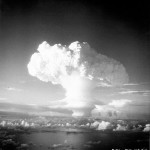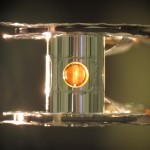SciTech Tuesday: Island Hopping, Nuclear Fusion and a Giant Laser
Seventy years ago, the Battle of Eniwetok was fought on the coral atoll in the Marshall Islands. Following success at Kwajalein, 330 miles to the southeast, Eniwetok offered an airfield and harbor essential to continuing the westward island hopping campaign towards mainland Japan. Facing well entrenched Japanese soldiers during the seven days of fighting, 262 American service members were killed, with 77 missing and 757 wounded.
Beginning in 1948, Eniwetok became the site of a decade of US nuclear testing. The first hydrogen bomb test occurred on Eniwetok on November 1, 1952. Code-named Ivy Mike, the 10.4 megaton device vaporized the small island of Elugelab. Yielding a power over 450 times that of the atomic bomb detonated over Nagasaki, Japan, the test produced a crater over 1.8 miles wide.
Fission devises, like those developed under the Manhattan Project during WWII, derive power from the splitting of the atomic nucleus creating two new smaller atoms. Hydrogen bombs, on the other hand, are thermonuclear devises that harness the power of fusion – the merging of two nuclei. As the name suggests, hydrogen bombs involve the fusion of two atoms of hydrogen, the smallest and lightest element in the universe. Two hydrogen nuclei join together forming one helium atom with small amount of mass is converted to energy. While atoms are extremely small and the amount of energy produced from one fusion event is tiny, large amounts of fusion produce immense amounts of energy. The sun, for example, fuses 686 million tons of hydrogen each second.
Recently, scientists have attempted to recreate conditions at the heart of the sun to harness the energy of nuclear fusion as a power source. Just last week, nuclear physicists working at the Lawrence Livermore National Laboratory in California announced that they successfully used a giant laser to fuse hydrogen atoms. Debbie Callahan, co-author of the study, compared the process of squeezing the hydrogen atoms to “compressing a basketball to the size of a pea.” While the energy required to initiate the fusion reaction exceeded the energy produced, the study is a critical milestone for the field of sustainable nuclear energy.
Post by Annie Tête, STEM Education Coordinator
- Posted :
- Post Category :
- Tags :
- Follow responses to this entry through the RSS 2.0 feed. You can skip to the end and leave a response. Pinging is currently not allowed.







Leave a Reply